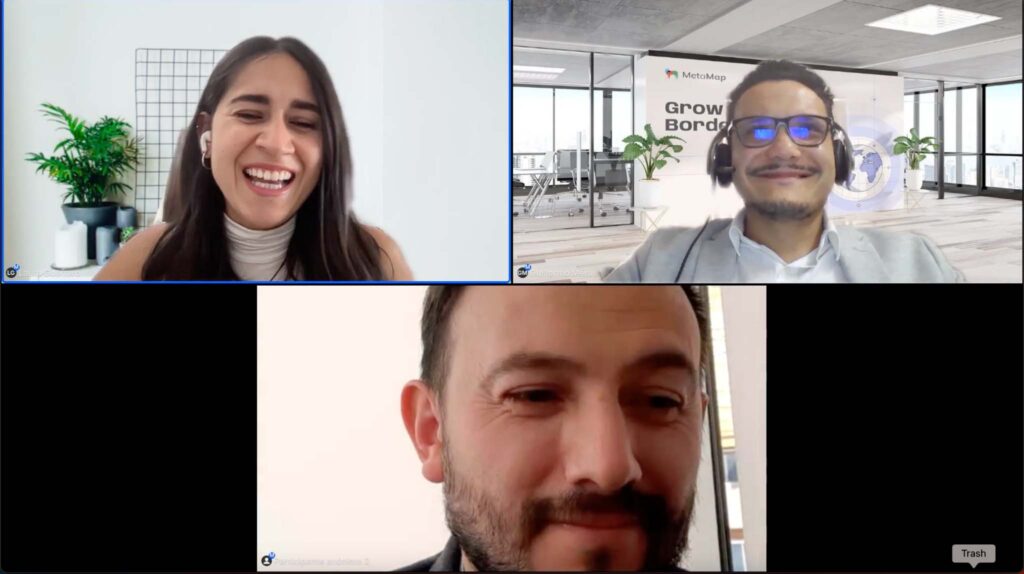Contents
 Luis Mercado
Luis Mercado
VP of Global Compliance for payment intermediaries
 Guillermo Mera
Guillermo Mera
Account Executive at MetaMap
 Laura Guerrero
Laura Guerrero
Head of Events and Marketing
Did you know that according to the Inter-American Development Bank (IDB), it is estimated that the amount of money from crime and corruption that is laundered in dummy companies represents between 2% and 5% of the world’s GDP each year, i.e., between 800,000 and 2 trillion dollars?
On this occasion, Laura Guerrero, Head of Events and Marketing, and Guillermo Mera, Account Executive at MetaMap, had the pleasure of speaking with Luis Mercado, a banking specialist, about compliance with anti-money laundering regulations.
Known by its acronym AML (Anti Money Laundering), this regulation dictates the procedures followed by financial institutions to prevent, detect, respond to, and eliminate the inherent and residual risks of money laundering, terrorist financing, and fraud.
As one can imagine, for the financial, fintech, banking, and cryptocurrency sectors, complying with international anti-money laundering standards is not an option, but a legal obligation.
“I firmly believe that the impact of financial institutions on communities is huge. However, there are crimes, such as financial crimes, including money laundering, which can strongly damage the accounting of these institutions and, in consequence, also harm the community.”
—Luis Mercado, banking specialist.

Following the money
Due to the amount of corruption, criminal groups, and illicit gains, AML regulations seek to prevent is this money from entering the legitimate financial system, either through banks, fintechs, or companies.
Luis has heard people say that these regulations are some sort of “trap” for the government to monitor people’s earnings. This is not the case, AML not only serves to stop criminals or corrupt politicians, but to also protect consumers.
“I’m hearing more and more opinions where people think that governments or international institutions seek to have money laundering prevention controls as a way to tax people. It seems like banks want to know how much you earn to tell the state and collect taxes, but that is quite far from reality.”
—Luis Mercado, banking specialist.
The regulations seek to define when legitimate money becomes ilegitimate. For example, if a company steals money from its investors or customers, this money immediately becomes dirty money.
When illegal money can mix in the financial system without limits, any opportunity to protect communities and curb the advance of corruption, abuse, and crime is lost.
Technology is an ally, but for whom?
The technological advance in handling money, both for depositing and withdrawing funds, has given a new level of comfort, ease, and inclusion to users of financial services. However, the same features that make life easier for the average citizen give new weapons to the corrupt politician or organized crime.
Many financial institutions or companies have developed technology controls to prevent illegal money from accessing the market. These same controls are often so strict that they sometimes block opportunities for thousands of people.
“Large institutions want to understand how this technology can allow o improve the user experience, we have seen huge investments from big banks in fintechs that have turned them into unicorns, but at the same time, they want to be careful with those businesses that can be used for speculation or to direct illicitly sourced funds.”
—Luis Mercado, banking specialist.
Institutions are forced to protect themselves while limiting opportunities for legitimate customers who cannot meet high standards.
How your company can tackle AML
Technology can help companies reduce the distrustful space that fraud, crime, and corruption have created between them and their customers. Biometric systems that help verify the identity of users are just some of the ways institutions can strengthen their controls and create inclusiveness in the market at the same time.
Companies should focus their efforts on:
- Compliance: Keep up to date with changes to legislation and adapt processes accordingly.
- Technology: Think of technology as your ally and not something to fear or even reject.
- Security: Implement processes that protect both clients andd the company
- Finance: A solid finance department makes it easier to spot possible fraud or money laundering.
According to Guillermo, companies need to learn to be “resilient.” This means that they cannot let legislation and changes stop them from always adapting. In the same vein, Luis believes that “creativity is key” for companies that want to survive in the future but don’t always have large resources.
Guillermo and Laura talked about how MetaMap is helping companies with technology that allows them to verify their customers while maintaining compliance with all regulations, including AML.
Through identity validation systems such as biometrics and document verification, MetaMap gives companies the possibility of removing the burden of compliance with regulations.
MetaMap offers high-security technologies that allow companies to offer more opportunities to customers in a safe manner. Guillermo believes that the role of MetaMap is key because “all compliance responsibility is assumed by MetaMap and not the customer.”
To learn more about how MetaMap can help your company defend against illegal acts and protect its customers, do not hesitate to contact us today and one of our experts will answer all your questions.
Related content
Subscribe to the newsletter and stay up to date with promotions, special offers and news


